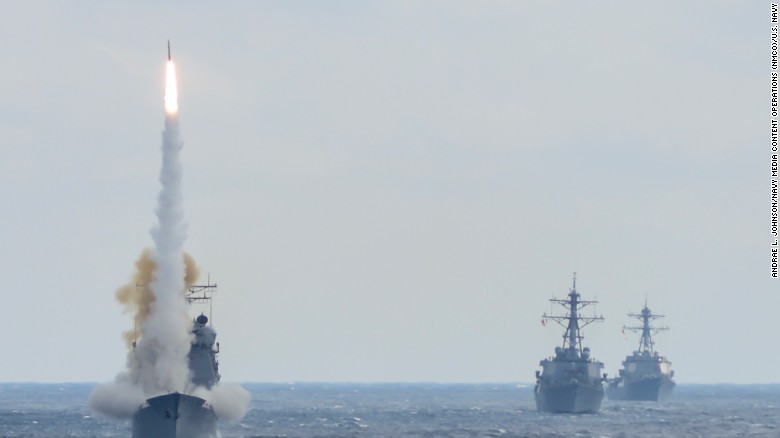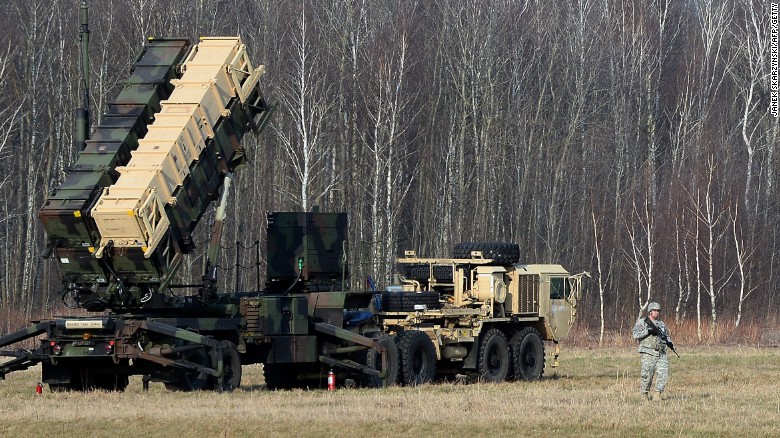(CNN)If North Korea fires a missile at a US target or ally, there are a number of defense systems that could shoot it down.
The first piece of the controversial THAAD missile defense system arrived in South Korea Monday night, hours after North Korea test-fired four ballistic missiles into the Sea of Japan, also known as the East Sea.
The Patriot and Aegis systems are already deployed in the Pacific region.
THAAD,
the Terminal High Altitude Area Defense system, can shoot down short-
and medium-range ballistic missiles in the latter stages of their flight
as they plunge toward their targets.
But
its presence in South Korea might be just as important for its
sophisticated radar -- the AN/TPY-2 X-Band radar -- which could provide
the first warning of any missile launched from North Korea.
Why does that matter?
The
missiles that North Korea fired Monday were thought to be of longer
range, designed for targets beyond South Korea. That would put THAAD
interceptors out of range.
But by
being closer to North Korea, THAAD's radar could provide critical early
tracking data to missile interception systems farther afield, such as
those protecting Japan or US bases in Guam, according to data from the
Pentagon's Missile Defense Agency.
Those
other protection systems, including the Aegis and Patriot missile
defense systems, are linked to THAAD by the US military's Command and
Control, Battle Management and Communications system, known as C2BMC,
according to contractor Lockheed Martin.
Could it have detected the most recent missiles?
The
THAAD battery's radar in South Korea would have detected the launch of
the North Korean missiles launched on Monday. Determining the missiles
were not targeting South Korea, the THAAD battery would send radar
tracking data to US Navy warships equipped with the Aegis missile
defense system sailing between South Korea and Japan.
The
Aegis ships would combine data from THAAD's radar with information from
their own AN/SPY-1 radar to track and fire interceptors at the enemy
missiles midflight, US military documents show.
If
Aegis interceptors were unable to make the intercept, data from both
the Aegis radar and the THAAD radar could be transmitted via the C2BMC
system to Patriot missile batteries, which are stationed closer to the
enemy's intended targets and would attempt to take out missiles as they
are plunging toward those targets, according to the Missile Defense
Agency.
Could a North Korean missile still hit its target?
The ballistic missile protection systems are not foolproof.Though Aegis is touted as being able to track more than 100 targets at one time, and has passed repeated tests, according to the US Navy, it has never taken out a ballistic missile in combat.
THAAD has also never been used in combat. And the system could be overwhelmed if North Korea were to launch a series of missiles simultaneously, according to a report from the North Korea monitoring group 38 North. It's also not effective against submarine-launched ballistic missiles launched from south, east or west of lower South Korea, 38 North said.
Patriot missile defenses have been tested in combat, taking out short-range ballistic missiles during the 1991 Gulf War and the 2003 invasion of Iraq, according to the Arms Control Association.
THAAD has also never been used in combat. And the system could be overwhelmed if North Korea were to launch a series of missiles simultaneously, according to a report from the North Korea monitoring group 38 North. It's also not effective against submarine-launched ballistic missiles launched from south, east or west of lower South Korea, 38 North said.
Patriot missile defenses have been tested in combat, taking out short-range ballistic missiles during the 1991 Gulf War and the 2003 invasion of Iraq, according to the Arms Control Association.
Which target is in the most danger?
The South Korean capital of Seoul, but not necessarily from ballistic missiles.
Seoul
sits only about 35 miles from the border with North Korea. That means
it could be struck by shorter range rockets and artillery, of which
North Korea has thousands of units.
Civilian
casualties in Seoul and its northern suburbs from a North Korean
artillery barrage could number in the thousands or more, experts have
said.
The only protection to such an attack would be an early warning to get in shelters.






